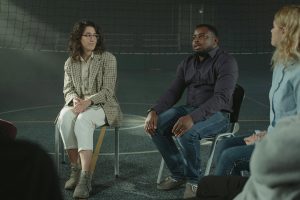“I failed at the swimming tryouts today. I’m no good at swimming, so I should just quit.” “What if I study now but still fail the exam tomorrow?” “My teacher complimented my art, but I know he was just being nice to me.” You might hear comments like these often from your teen.
These are examples of a common type of thinking error known as cognitive distortion. They are biased perspectives and inaccurate thoughts based on a negative view of things.
Aaron Beck, the father of cognitive behavior therapy (CBT), first noted these thinking patterns in his 1963 research. It became an important part of his cognitive theory of depression and a significant aspect of cognitive behavioral therapy.
In this article, you will learn more about cognitive distortions in teens and how group therapy can help them challenge this kind of thinking.
Understanding Cognitive Distortion in Teens
Teens can be very self-critical, particularly if they struggle with mental health issues. While occasionally having negative thoughts is normal, repetitive thinking errors may lead to anxiety, depression, and anger management issues in teens.
Negative thinking patterns are often irrational and unrealistic, and they can negatively impact teens’ emotions, behaviors, and perspectives of the world.
Below are some common examples of cognitive distortion in teens:
- All-or-Nothing Thinking: Also known as black-and-white thinking, this is seeing things in extremes, such as only good or bad instead of shades of gray. For example, making a few mistakes on an exam and thinking they’re a failure even if they passed.
- Overgeneralization: This is making a general conclusion based on one event or negative situation. For example, a teen might think, “I made a mistake. I always make mistakes and never do anything right.”
- Catastrophizing: Also known as magnification, this thinking error takes small problems and blows them out of proportion. A teen might think, “If I don’t make a good impression on the first day of school, my classmates won’t like me. I will never have friends and be a loner forever!”
- Labeling: Assigning labels to the self or others can lead to low self-esteem or affect relationships with others. For example, a teen might accidentally break a plate while washing dishes and automatically think, “I’m a failure and can’t do anything right!”.
- Personalization: Teens with this type of thinking error usually believe they’re the ones to blame for a negative situation, even if it’s out of their control. For instance, they might think, “My friend has not messaged me for a while now. I must have done something wrong,” even if that friend is just busy with homework.
- Disqualifying The Positive: This thinking error leads teens to ignore compliments, thinking they were just lucky or that the person who said the compliment was only being nice.
The Role of Cognitive Behavioral Group Therapy (CBGT) in Challenging Cognitive Distortions
Often, thinking errors in teens are so habitual that they don’t realize they’re automatically resorting to unrealistic thoughts.
If you notice your kids having cognitive distortions often, it’s a good idea to contact a mental health professional. They are trained and experienced in helping people develop a more healthy way of thinking. These professionals will help them challenge their thought patterns and apply the strategies used in cognitive behavioral therapy (CBT).
CBT is a psychotherapeutic treatment that aims to help people identify unhelpful thought and behavior patterns. The main idea is that our thoughts, emotions, and behaviors are connected. The way teens interpret their experiences can influence their emotions and behavior.
Cognitive Behavioral Group Therapy (CBGT) can also be helpful for teens. In a group, a therapist will help teens recognize thinking errors that have negative effects on their emotions and behaviors.
Since CBGT is done in a group, it allows teens to connect with others who can relate to their situation. Working with a group can help them improve their thinking patterns in a safe space, realizing they’re not alone in their struggles.
Characteristics of Effective CBGT
An effective CBGT program will have the following characteristics:
- Capable and supportive facilitators: CBGT has experienced facilitators who will help the group have meaningful discussions. Effective facilitators are observant and able to address challenges early. They can help the group give and receive feedback in a healthy way.
- Structured meetings: A typical CBGT session with teens will have a goal and a structure for each meeting. For every session, there is an agenda or tasks to accomplish.
- Promotes Collaboration: CBGT promotes collaboration between participants, allowing them to work together for a goal and share ideas and feedback. Facilitators will encourage participants to share their thoughts honestly and empower one another. In an effective group, each member is interested in everyone’s success.
Techniques Used in CBGT to Challenge Cognitive Distortions
Bernstein and Christner (2016) listed the techniques used in CBGT. The strategies below can be used to help teens challenge cognitive distortions:
- Psychoeducation: Considered the first component in CBT and CBGT programs for adolescents, psychoeducation involves orienting the group members about the CBT model. The participants learn about the connection between situations, beliefs, emotions, and behaviors.
- Cognitive Restructuring: After psychoeducation, participants are taught to identify maladaptive thought patterns. This helps them to be aware of thoughts and beliefs that may be faulty. Next, participants are encouraged to challenge their thinking errors and develop alternative ways of thinking.
- Relaxation Training: Relaxation is a coping skill CBT therapists teach to help adolescents be aware of physiological sensations and help them with their problems, such as headaches and stomachaches.
- Role Play: In CBGT, role plays are enacted between the therapist and group members to help teens practice their cognitive, behavioral, and problem-solving skills.
- Teaching Problem-Solving Skills: This involves teens learning problem-solving skills to help them be confident when faced with new situations and encourage them to challenge their thinking errors. They are taught to solve problems by identifying the issue, thinking of solutions, imagining the outcome, and evaluating the results.
- Homework: A therapist will assign homework to encourage teens to practice newly learned skills and strategies in their daily lives. The homework is reviewed during the next session, and group members can provide feedback and support other members. This helps each participant learn from one another.
- Planning for Generalization and Maintenance: To support participants’ use of their newly learned skills, they must have opportunities to use them at home, school, and in the community. A facilitator, together with the parents of the teen, can help plan for this.
Summary
Cognitive distortions, also known as thinking errors, can affect teens’ emotions and behavior — leading to problems such as low self-esteem, depression, and anxiety. Cognitive behavioral therapy (CBT) can help them identify inaccurate thoughts to help them improve their mood and behavior.
CBT can be implemented for individuals and groups. Cognitive Behavioral Group Therapy (CBGT) helps your teen develop newly learned skills within a group while also having the opportunity to learn from others’ experiences. The group setting can act as a safe space with others who will support your teen and offer empathy.
If you or someone you know experiences mental health issues, it is important to seek help from a qualified professional. Our Resource Specialists can help you find expert mental health resources to recover in your community. Contact us now for more information on this free service to our users.
About the Author: Michael Vallejo is a Child and Family Therapist with a private practice in Colorado Springs, Colorado. Through Mental Health Center Kids, he hopes to support other therapists, parents, teachers, and mental health professionals with visually appealing online resources to support the well-being of kids in their care.
Photo by Keira Burton: https://www.pexels.com/photo/group-of-joyful-young-multiethnic-friends-talking-on-street-after-university-classes-6147076/
The opinions and views expressed in any guest blog post do not necessarily reflect those of www.rtor.org or its sponsor, Laurel House, Inc. The author and www.rtor.org have no affiliations with any products or services mentioned in the article or linked to therein. Guest Authors may have affiliations to products mentioned or linked to in their author bios.
Recommended for You
- The Truth about Relapse in Addiction Recovery - April 14, 2025
- The Power of Peer Support in Mental Health Recovery - April 10, 2025
- Artificial Intelligence in Anxiety Management: How AI Helps Users Cope with Anxiety Symptoms - April 3, 2025





